#i fuckin love reading the planet bios lore
Explore tagged Tumblr posts
Photo
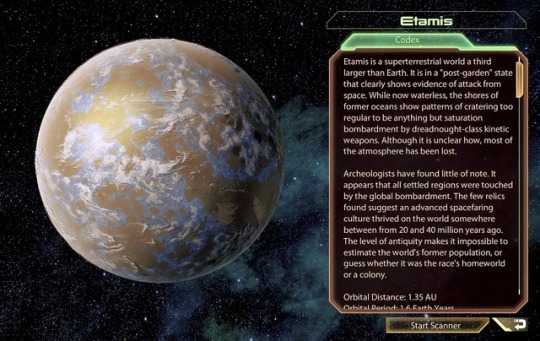

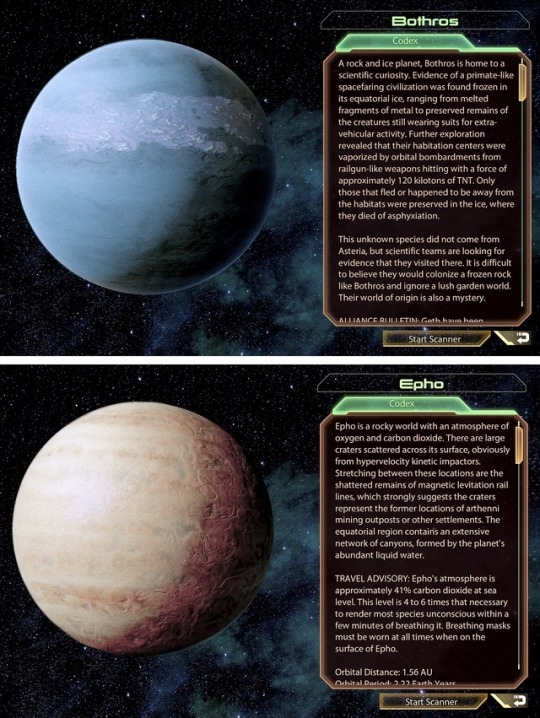
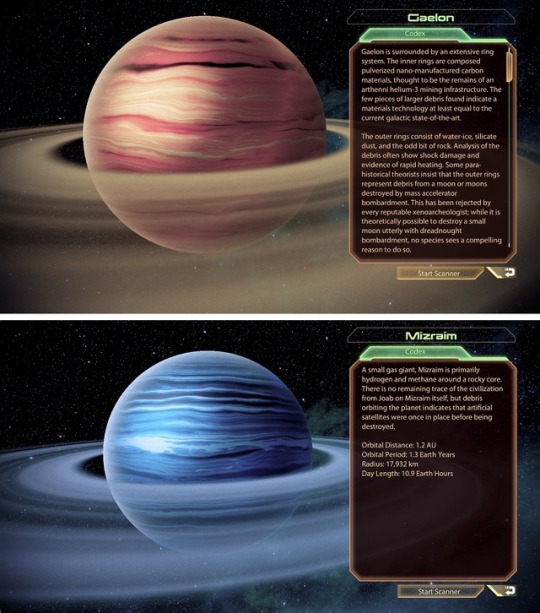
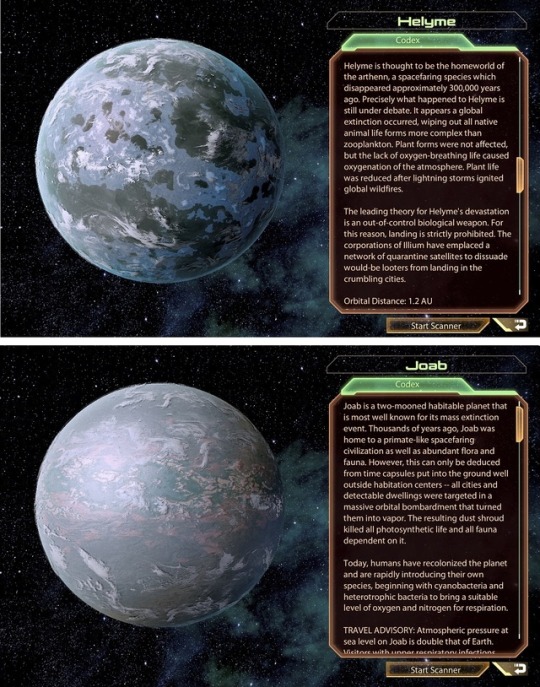

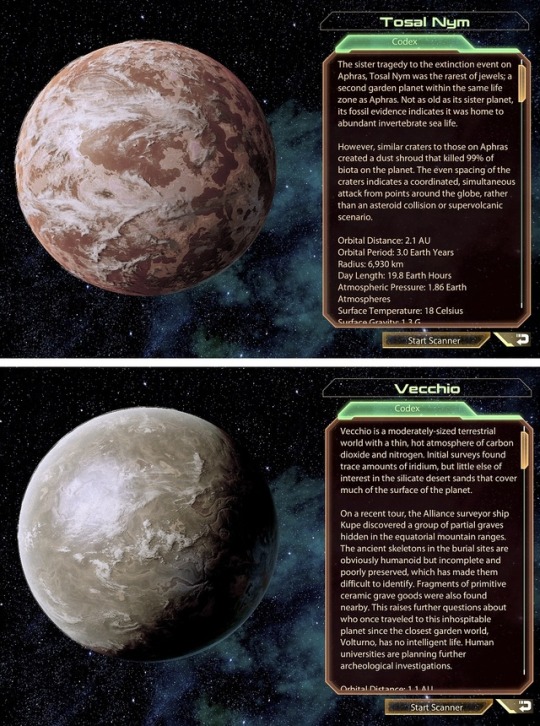
Archaeological evidence of mass extinctions Planetary biographies below the cut
Aphras is a “heavenly twin,” a planet in a star system that has not one but two worlds of sufficient mass to retain a nitrogen-oxygen atmosphere within the habitable life zone of its parent star. Fossil evidence shows abundant vertebrates and evidence of a sapient terrestrial avian species in its Bronze Age.
However, the only trace of contemporary life on the planet is that of single-celled organisms in its seas. All else has suffered from an extinction event – a series of massive impacts that vaporized vast quantities of water and lofted dust into its atmosphere. Early theories that this event was a collision with a fragmenting asteroid have now been discounted – the impact craters were aimed directly at habitation centers. (see: Tosal Nym)
Atahil is only of note for a few scattered craters. Though flattened by millions of years of high pressure, the marks of orbital bombardment strikes are unmistakable. It is generally accepted among academics that whoever hailed from or settled Schwarzschild’s second planet, Etamis, must have had outposts on Atahil as well.
Bothros is home to a scientific curiosity. Evidence of a primate-like spacefaring civilization was found frozen in its equatorial ice, ranging from melted fragments of metal to preserved remains of the creatures still wearing suits for extra-vehicular activity. Further exploration revealed that their habitation centers were vaporized by orbital bombardments from railgun-like weapons hitting with a force of approximately 120 kilotons of TNT. Only those that fled or happened to be away from the habitats were preserved in the ice, where they died of asphyxiation.
This unknown species did not come from Asteria, but scientific teams are looking for evidence that they visited there. It is difficult to believe they would colonize a frozen rock like Bothros and ignore a lush garden world. Their world of origin is also a mystery.
Epho is a rocky world with an atmosphere of oxygen and carbon dioxide. There are large craters scattered across its surface, obviously from hypervelocity kinetic impactors. Stretching between these locations are the shattered remains of magnetic levitation rail lines, which strongly suggests the craters represent the former locations of arthenni mining outposts or other settlements. The equatorial region contains an extensive network of canyons, formed by the planet’s abundant liquid water. (see: Gaelon, Helyme)
Etamis is a superterrestrial world a third larger than Earth. It is in a “post-garden” state that clearly shows evidence of attack from space. While now waterless, the shores of former oceans show patterns of cratering too regular to be anything but saturation bombardment by dreadnought-class kinetic weapons. Although it is unclear how, most of the atmosphere has been lost.
Archeologists have found little of note. It appears that all settled regions were touched by the global bombardment. The few relics found suggest an advanced spacefaring culture thrived on the world somewhere between from 20 and 40 million years ago. The level of antiquity makes it impossible to estimate the world’s former population, or guess whether it was the race’s homeworld or a colony.
Helyme is a “post-garden” world that once enjoyed an Earth-like oxygen-nitrogen atmosphere. It is still blessed with plentiful water, but a generally cold climate (and extreme seasonal shifts, courtesy of a 38-degree axial tilt).
Helyme is thought to be the homeworld of the arthenn, a spacefaring species which disappeared approximately 300,000 years ago. Precisely what happened to Helyme is still under debate. It appears a global extinction occurred, wiping out all native animal life forms more complex than zooplankton. Plant forms were not affected, but the lack of oxygen-breathing life caused oxygenation of the atmosphere. Plant life was reduced after lightning storms ignited global wildfires.
The leading theory for Helyme’s devastation is an out-of-control biological weapon. For this reason, landing is strictly prohibited. The corporations of Illium have emplaced a network of quarantine satellites to dissuade would-be looters from landing in the crumbling cities. (see: Epho, Gaelon)
Joab is a two-mooned habitable planet that is most well known for its mass extinction event. Thousands of years ago, Joab was home to a primate-like spacefaring civilization as well as abundant flora and fauna. However, this can only be deduced from time capsules put into the ground well outside habitation centers – all cities and detectable dwellings were targeted in a massive orbital bombardment that turned them into vapor. The resulting dust shroud killed all photosynthetic life and all fauna dependent on it. (see: Laban, Mizraim)
Klendagon’s most striking feature is, of course, the Great Rift valley that stretches across the southern hemisphere. What is most fascinating about the Rift is that it does not appear to be natural. The geological record suggests it is the result of a “glancing blow” by a mass accelerator round of unimaginable destructive power. This occurred some thirty-seven million years ago.
Gaelon is surrounded by an extensive ring system. The inner rings are composed pulverized nano-manufactured carbon materials, thought to be the remains of an arthenni helium-3 mining infrastructure. The few pieces of larger debris found indicate a materials technology at least equal to the current galactic state-of-the-art.
The outer rings consist of water-ice, silicate dust, and the odd bit of rock. Analysis of the debris often show [sic] shock damage and evidence of rapid heating. Some para-historical theorists insist that the outer rings represent debris from a moon or moons destroyed by mass accelerator bombardment. This has been rejected by every reputable xenoarcheologist; while it is theoretically possible to destroy a small moon utterly with dreadnought bombardment, no species sees a compelling reason to do so. (see: Epho, Helyme)
Mizraim, a small gas giant, is primarily hydrogen and methane around a rocky core. There is no remaining trace of the civilization from Joab on Mizraim itself, but debris orbiting the planet indicates that artificial satellites were once in place before being destroyed. (see: Joab, Laban)
Klendagon is an arid terrestrial, slightly larger than Earth, but with a lower density that reflects its relative lack of heavier elements. The crust is composed of tin and aluminum, with wide deserts of dust-fine sand that are easily stirred by the wind.
Klendagon’s most striking feature is, of course, the Great Rift valley that stretches across the southern hemisphere. What is most fascinating about the Rift is that it does not appear to be natural. The geological record suggests it is the result of a “glancing blow” by a mass accelerator round of unimaginable destructive power. This occurred some thirty-seven million years ago.
Laban is a desert world with sea upon sea of scorching hot iron oxide wearing away marbleized cliffs. Its atmosphere is thick and layered with significant levels of oxygen trapped under an upper helium layer. Initially, surveyors detected traces of iridium from orbit, only to find a surprising archaeological discovery - the iridium came from bunkers on the surface that were blown apart by a dreadnought-class weapon. The logical conclusion was that the civilization on Joab had reached Laban and its outposts here were destroyed to make their extermination complete. (see: Joab, Mizraim)
Tosal Nym, [ the sister tragedy to the extinction event on Aphras ], was the rarest of jewels; a second garden planet within the same life zone as Aphras. Not as old as its sister planet, its fossil evidence indicates it was home to abundant invertebrate sea life.
However, similar craters to those on Aphras created a dust shroud that killed 99% of biota on the planet. The even spacing of the craters indicates a coordinated, simultaneous attack from points around the globe, rather than an asteroid collision or supervolcanic scenario. (see: Aphras)
Vecchio is a moderately-sized terrestrial world with a thin, hot atmosphere of carbon dioxide and nitrogen. Initial surveys found trace amounts of iridium, but little else of interest in the silicate desert sands that cover much of the surface of the planet.
On a recent tour, the Alliance surveyor ship Kupe discovered a group of partial graves hidden in the equatorial mountain ranges. The ancient skeletons in the burial sites were obviously humanoid but incomplete and poorly preserved, which has made them difficult to identify. Fragments of primitive ceramic grave goods were also found nearby. This raises further questions about who once traveled to this inhospitable planet since the closest garden world, Volturno, has no intelligent life. Human universities are planning further archaeological investigations.

788 notes
·
View notes